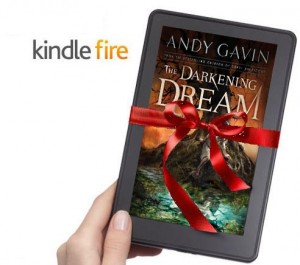 On February 7-8 I ran a Kindle Select sale giving away The Darkening Dream free (Kindle version) for 48 hours. Free downloads were fantastic and the book was nailed to number 4 overall in the Kindle store for almost two days (details here).
On February 7-8 I ran a Kindle Select sale giving away The Darkening Dream free (Kindle version) for 48 hours. Free downloads were fantastic and the book was nailed to number 4 overall in the Kindle store for almost two days (details here).
But what about real sales?
The two hours immediately after the sale ends are really crucial. When my novel when off free, my free ranking had slipped to about #7. For about two hours it was no longer free but was still listed there on the first page of the bestseller list in the free column. During this period, it slid slowly down to #11. Meanwhile, with this high visibility, people were still clicking through in high numbers. Watching the sales figures, I saw approximately 1500 ”buys” during this period. But what I don’t know is how many of them were free and how many paid. Amazon reports both in the same column! Only when the February sales report comes in mid-March will I be sure. However, during the next 24 hours I received about 50 returns which has me suspecting a good number of these were paid — and in some cases unintentional. Amazon does not distinguish between free and paid in a very obvious manner and the one-click button looks virtually identical in both cases.
The day immediately following the sale, downloads slumped, to about thirty. After the rush of “selling” several hundred copies an hour (for free) this was a serious letdown. I panicked, and dropped my price from $4.99 to $2.99. But then, almost exactly 24 hours after going back to being paid, whatever mysterious promotion Amazon does in the wake of a successful free days kicked in.
I sold about 200 copies the next day. And about the same the day after. My paid sales ranking peaked at 398. Then two days of about 70 copies a day, then sales have slowly drifted downward. Still, even three weeks later, they’re better than they were before the free day. In addition, the promotion resulted in reaching thousands of new readers who wouldn’t otherwise have found the book and also generated numerous reviews and small articles. Overall, a definite success, but despite having ranked extremely high during the free period, did not in of itself create a longterm sustaining sales momentum.
Some advice for those planning free days:
1. Plan on either one or two days but do not commit to both. You may need to gauge the momentum of your sale so that you can exit with the highest possible ranking.
2. Promote the hell out of your first day. Notify all possible sites that announce free books, particularly pixel of ink. This one seems most effective on downloads. Buy some of these ads if you can.
3. Before running your day, be sure you have the best description and cover possible as well as a decent complement of reviews.
4. Offer sacrifice to Promotius, Roman God of sales and marketing.
Since putting the book on the market two months ago I’ve tried a great number of promotional tactics and this has probably been the most successful, still, I’m searching for a truly great way to get the book in front of more readers. If you have a good product — and reviews seem to back up my assumption that I do — book marketing is all about exposure. There are a tremendous number of books out there, far far more than even the most aggressive reader could actually read, so people are unlikely to just stumble upon your book by accident. Bestsellers aren’t just fun reads — and they generally are — but also benefit massively from the social nature of reading. We don’t want to be left out of the latest cultural phenomenon. They reach that position by luck, marketing, or phenomenon. Or sometimes all three.



